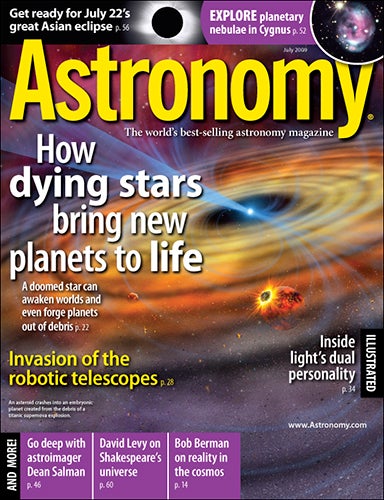
WAUKESHA, Wis. — Roughly 5 billion years from now, the Sun will go through a late-life crisis as its internal temperature spikes and its outer layers expand. Earth will migrate out to Mars’ current orbit, but the tidal forces between this red giant Sun and Earth will drag the planet back inward, making Earth virtually uninhabitable. Elsewhere in the solar system, once-frozen worlds like Jupiter’s Europa could experience spring for the first time and potentially become incubators for the first stages of life.
This is only one way a doomed star can lead to the creation of new worlds. In “How dying stars bring new planets to life,” Ray Villard, news director of the Space Telescope Science Institute in Baltimore, discusses the different possibilities for star death to awaken habitable worlds and even forge new planets out of death’s debris.
“The conditions for planetary birth, survival, and rebirth seem common throughout a cosmos that, ironically, is indifferent to maintaining planetary paradises for very long,” Villard writes. “Nevertheless, the fundamental physics of the universe seems adept at rebuilding entire planets from the ashes of star death.”
Pick up the July issue of Astronomy, on newsstands June 2, to learn more about the potential for post-apocalyptic worlds.
“Invasion of the robotic telescopes”
The traditional image of an astronomer is someone staying up all night squinting into an eyepiece to study the sky. But eyepieces have been swapped out for new technologies and sensors, and now robotic systems are even replacing some of the astronomers. “Invasion of the robotic telescopes,” by Associate Editor Daniel Pendick, explains how faster and smarter telescopes are taking over much of the nightly astronomical research and soon may begin making their own discoveries.
“Get ready for the great Asian eclipse”
On July 22, 2009, a cone of darkness will cut a narrow course through eastern Asia and the western Pacific as the Sun and Moon align. In “Get ready for the great Asian eclipse,” Senior Editor Richard Talcott previews what will be the 21st century’s longest total solar eclipse, producing an amazing 6 minutes and 39 seconds of totality.
The Cosmic Grid
This month, Astronomy introduces The Cosmic Grid, a new department that features some of the most unusual recent factoids, news bits, and random thoughts about astronomy and space exploration in a graphical format. “The idea is to describe a fact, event, action, or object and locate it in a graphical space consisting of two axes: hot/not and weird/predictable,” says Pendick, the mind behind this new department.
Also in the July 2009 Astronomy
- “Light’s dual personality” — Is light a wave or a particle? Science says both.
- “Explore planetary nebulae in Cygnus” — These dying stars offer colored rings, twisted filaments, and odd-shaped blobs.
- “Go deep for faint nebulae with astroimager Dean Salman” — A dark sky, wide-field scope, and filtered CCD camera enable this Arizona skyshooter to capture distant HII regions in the Milky Way.
- “The Sky This Month” — Exclusive pullout star charts will guide you through July’s night sky.
- The July issue of Astronomy also includes Astro News, Bob Berman’s Strange Universe, Glenn Chaple’s Observing Basics, David Levy’s Evening Stars, Stephen James O’Meara’s Secret Sky, Ask Astro, Astro Confidential, Telescope Insider, New Products, and Reader Gallery.









